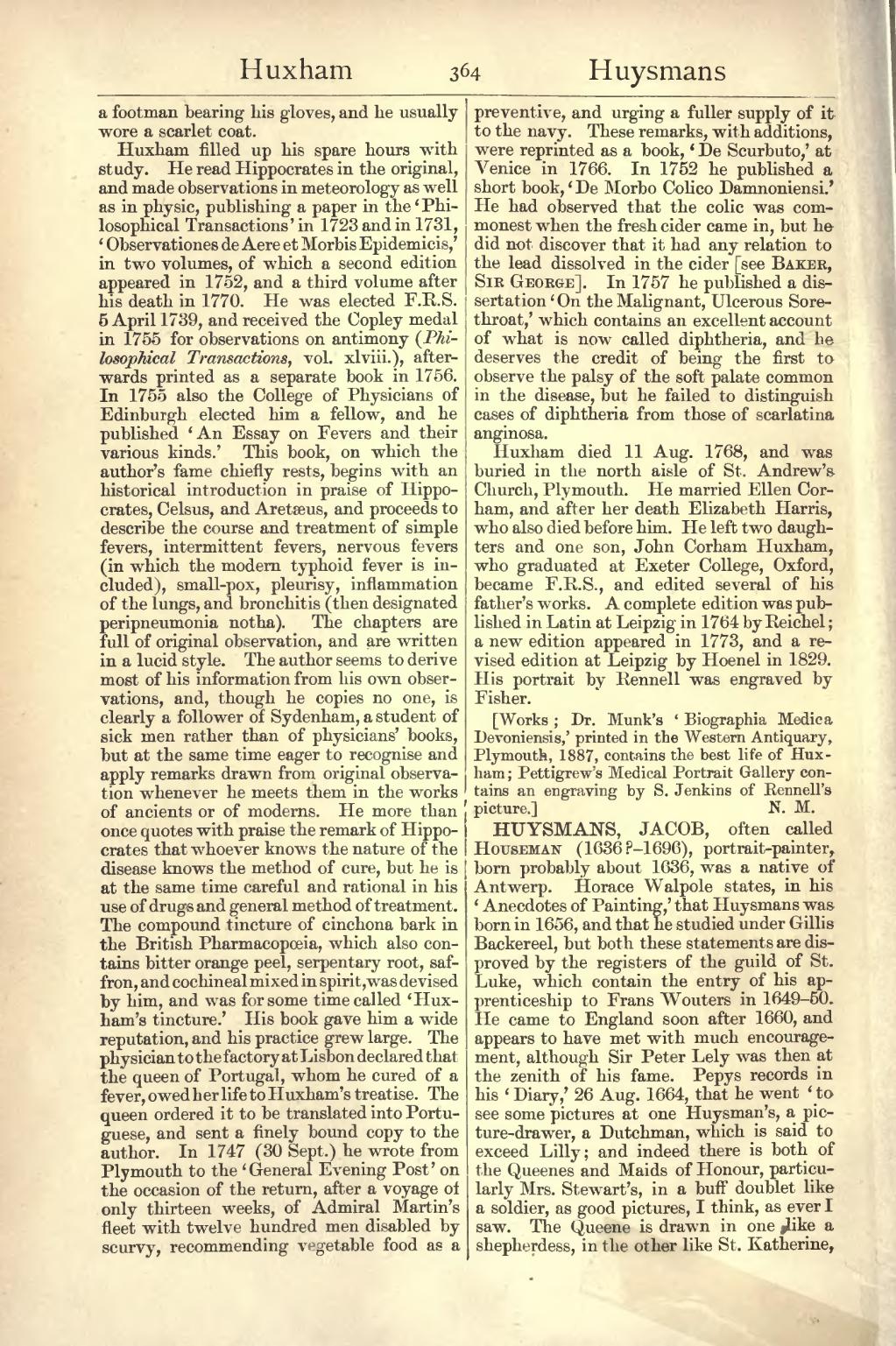a footman bearing his gloves, and he usually wore a scarlet coat.
Huxham filled up his spare hours with study. He read Hippocrates in the original, and made observations in meteorology as well as in physic, publishing a paper in the 'Philosophical Transactions' in 1723 and in 1731, 'Observationes de Aere et Morbis Epidemicis,' in two volumes, of which a second edition appeared in 1752, and a third volume after his death in 1770. He was elected F.R.S. 5 April 1739, and received the Copley medal in 1755 for observations on antimony (Philosophical Transactions, vol. xlviii.), afterwards printed as a separate book in 1756. In 1755 also the College of Physicians of Edinburgh elected him a fellow, and he published 'An Essay on Fevers and their various kinds.' This book, on which the author's fame chiefly rests, begins with an historical introduction in praise of Hippocrates, Celsus, and Aretseus, and proceeds to describe the course and treatment of simple fevers, intermittent fevers, nervous fevers (in which the modern typhoid fever is included), small-pox, pleurisy, inflammation of the lungs, and bronchitis (then designated peripneumonia notha). The chapters are full of original observation, and are written in a lucid style. The author seems to derive most of his information from his own observations, and, though he copies no one, is clearly a follower of Sydenham, a student of sick men rather than of physicians' books, but at the same time eager to recognise and apply remarks drawn from original observation whenever he meets them in the works of ancients or of moderns. He more than once quotes with praise the remark of Hippocrates that whoever knows the nature of the disease knows the method of cure, but he is at the same time careful and rational in his use of drugs and general method of treatment. The compound tincture of cinchona bark in the British Pharmacopoeia, which also contains bitter orange peel, serpentary root, saffron, and cochineal mixed in spirit, was devised by him, and was for some time called 'Huxham's tincture.' His book gave him a wide reputation, and his practice grew large. The physician to the factory at Lisbon declared that the queen of Portugal, whom he cured of a fever, owed her life to Huxham's treatise. The queen ordered it to be translated into Portuguese, and sent a finely bound copy to the author. In 1747 (30 Sept.) he wrote from Plymouth to the 'General Evening Post' on the occasion of the return, after a voyage of only thirteen weeks, of Admiral Martin's fleet with twelve hundred men disabled by scurvy, recommending vegetable food as a preventive, and urging a fuller supply of it to the navy. These remarks, with additions, were reprinted as a book, ‘De Scurbuto,' at Venice in 1766. In 1752 he published a short book, 'De Morbo Colico Damnoniensi,' He had observed that the colic was commonest when the fresh cider came in, but he did not discover that it had any relation to the lead dissolved in the cider [see Baker, Sir George]. In 1757 he published a dissertation 'On the Malignant, Ulcerous Sore-throat,' which contains an excellent account of what is now called diphtheria, and he deserves the credit of being the first to observe the palsy of the soft palate common in the disease, but he failed to distinguish cases of diphtheria from those of scarlatina anginosa.
Huxham died 11 Aug. 1768, and was buried in the north aisle of St. Andrew's Church, Plymouth. He married Ellen Corham, and after her death Elizabeth Harris, who also died before him. He left two daughters and one son, John Corham Huxham, who graduated at Exeter College, Oxford, became F.R.S., and edited several of his father's works. A complete edition was published in Latin at Leipzig in 1764 by Reichel; a new edition appeared in 1773, and a revised edition at Leipzig by Hoenel in 1829. His portrait by Rennell was engraved by Fisher.
[Works; Dr. Munk's 'Biographia Medic a Devoniensis,' printed in the Western Antiquary, Plymouth, 1887, contains the best life of Huxham; Pettigrew's Medical Portrait Gallery contains an engraving by S. Jenkins of Rennell's picture.]
HUYSMANS, JACOB, often called Houseman (1636?–1696), portrait-painter, born probably about 1636, was a native of Antwerp. Horace Walpole states, in his 'Anecdotes of Painting,' that Huysmans was born in 1656, and that he studied under Gillis Backereel, but both these statements are disproved by the registers of the guild of St. Luke, which contain the entry of his apprenticeship to Frans Wouters in 1649-50. He came to England soon after 1660, and appears to have met with much encouragement, although Sir Peter Lely was then at the zenith of his fame. Pepys records in his 'Diary,' 26 Aug. 1664, that he went 'to see some pictures at one Huysman's, a picture-drawer, a Dutchman, which is said to exceed Lilly; and indeed there is both of the Queenes and Maids of Honour, particularly Mrs. Stewart's, in a buff doublet like a soldier, as good pictures, I think, as ever I saw. The Queene is drawn in one like a shepherdess, in the other like St. Katherine,
